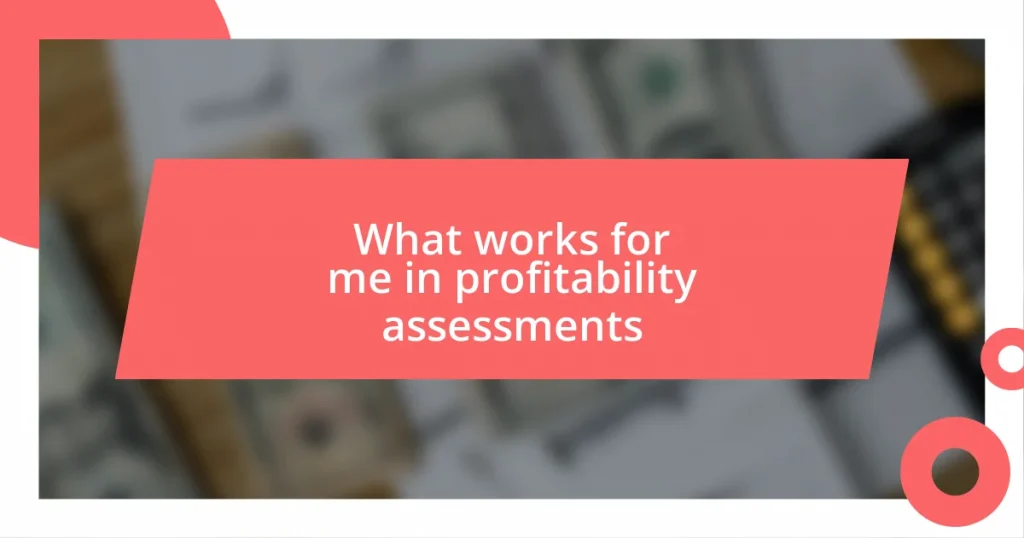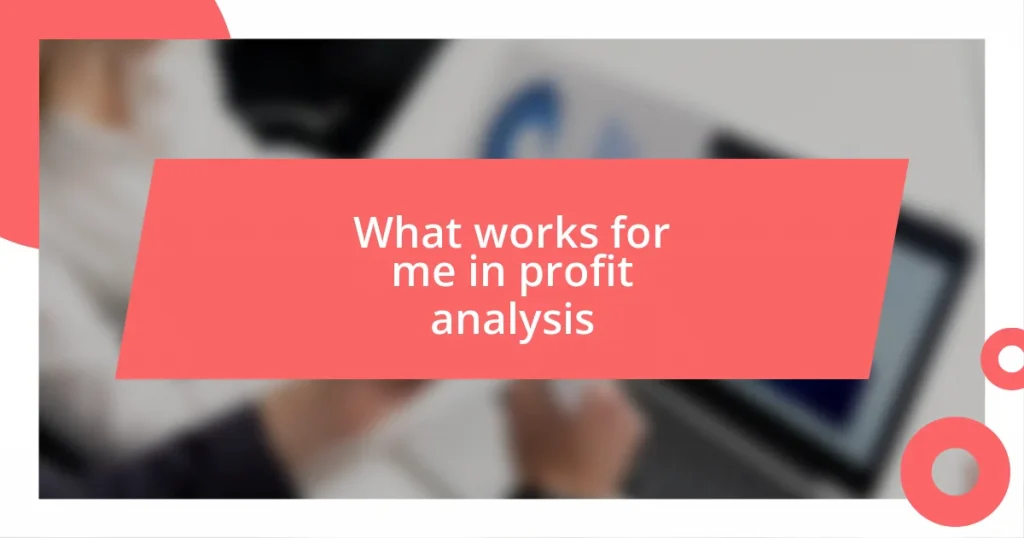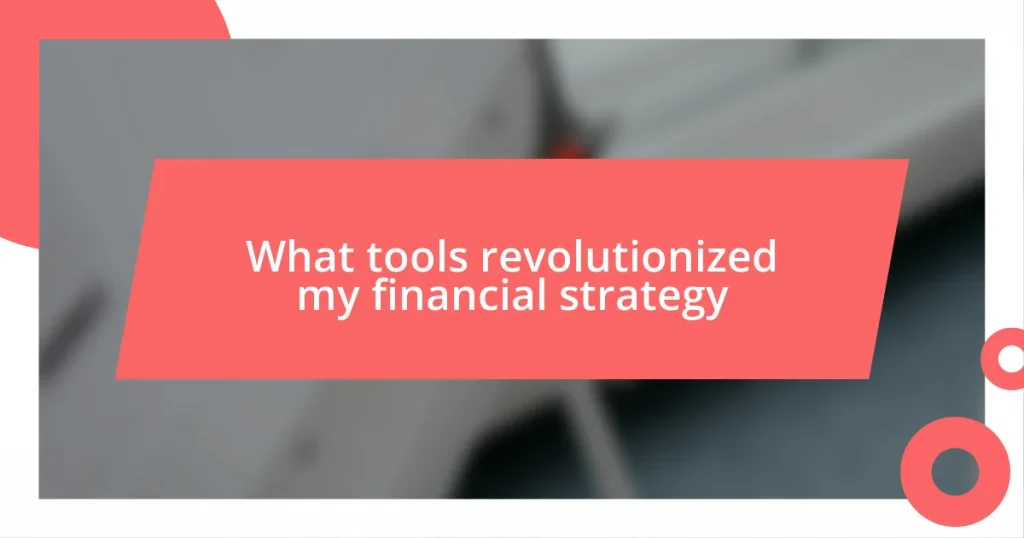Key takeaways:
- Understanding and prioritizing key performance indicators (KPIs) can transform business strategies and highlight the relationship between metrics like customer acquisition cost and overall success.
- Utilizing effective tracking tools such as Google Analytics and CRM software enables businesses to visualize data trends, making informed decisions easier and more strategic.
- Regular performance reviews and open communication foster a culture of continuous improvement, allowing teams to adapt strategies, innovate, and strengthen collaboration.

Understanding business performance metrics
Understanding business performance metrics goes beyond merely crunching numbers; it’s about grasping the story those numbers tell. I remember when I first dove into metrics, feeling overwhelmed by the data. But as I learned to focus on key performance indicators (KPIs), it became clear that these metrics are just a way to measure success, profitability, and overall health of the business.
One of my biggest “aha” moments came when I realized that not all metrics are created equal. For instance, tracking customer acquisition cost was eye-opening for me. It’s not just a figure; it reflects the efficiency of my marketing efforts and helps me make informed decisions. Isn’t it fascinating how one metric can shift your perspective on your marketing strategy?
And then there are qualitative metrics that, while less tangible, offer invaluable insights into employee satisfaction or customer loyalty. After implementing regular feedback loops in my business, I saw how understanding team morale directly impacted productivity. Have you ever considered how your team’s happiness could influence your bottom line? The connection is more profound than I initially thought, and it’s made me rethink what performance truly means in my business.
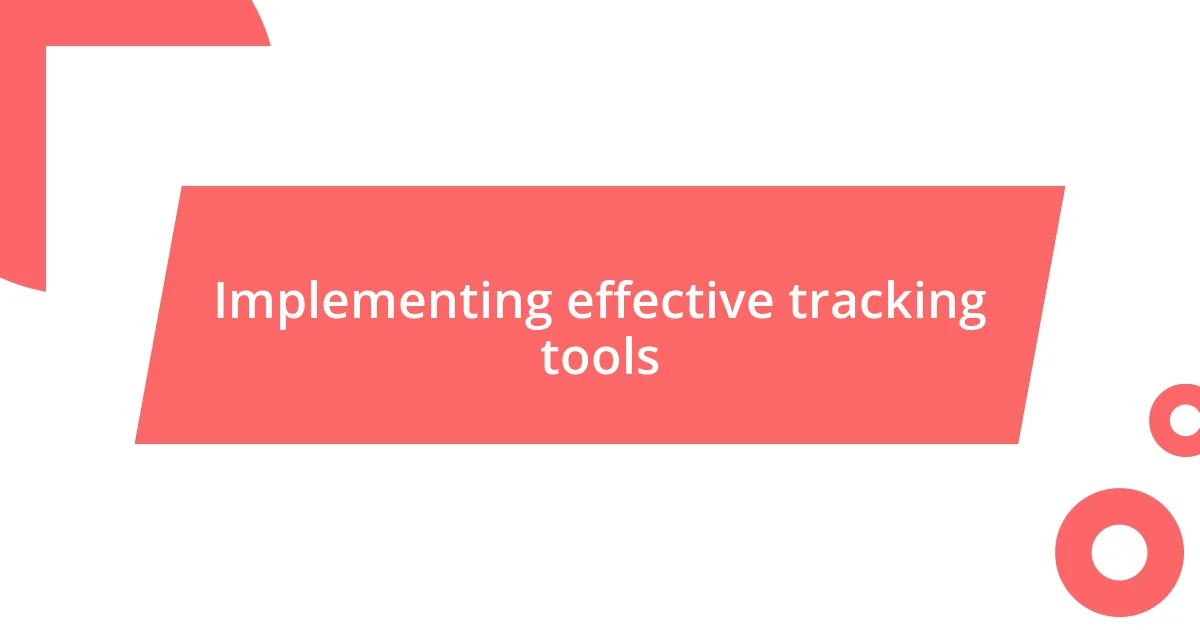
Implementing effective tracking tools
Implementing effective tracking tools is a game-changer for any business. In my experience, using software like Google Analytics transformed how I viewed data. Suddenly, I wasn’t just collecting numbers; I was able to visualize trends and patterns that drove strategic decisions. I remember the first time I noticed a spike in web traffic during a marketing campaign; it felt like a light bulb went off, guiding my next steps.
It’s crucial to choose the right tools that align with your business goals. I once tried a popular CRM tool that promised comprehensive tracking features, but it felt overly complex for my needs. After switching to a more streamlined solution, I saw an immediate improvement in my workflow. Have you ever felt bogged down by technology that should make your life easier? Finding the right fit matters.
Certain tools excel at specific tasks, making side-by-side comparisons invaluable. After trying several, I realized that while one tool might be perfect for tracking sales, another could shine at monitoring social media engagement. This realization made me more intentional with my choices, ensuring I invested in multiple tools that excelled in their respective areas.
| Tool | Best For |
|---|---|
| Google Analytics | Website and conversion tracking |
| Salesforce | Comprehensive customer relationship management |
| HubSpot | Marketing automation and lead tracking |
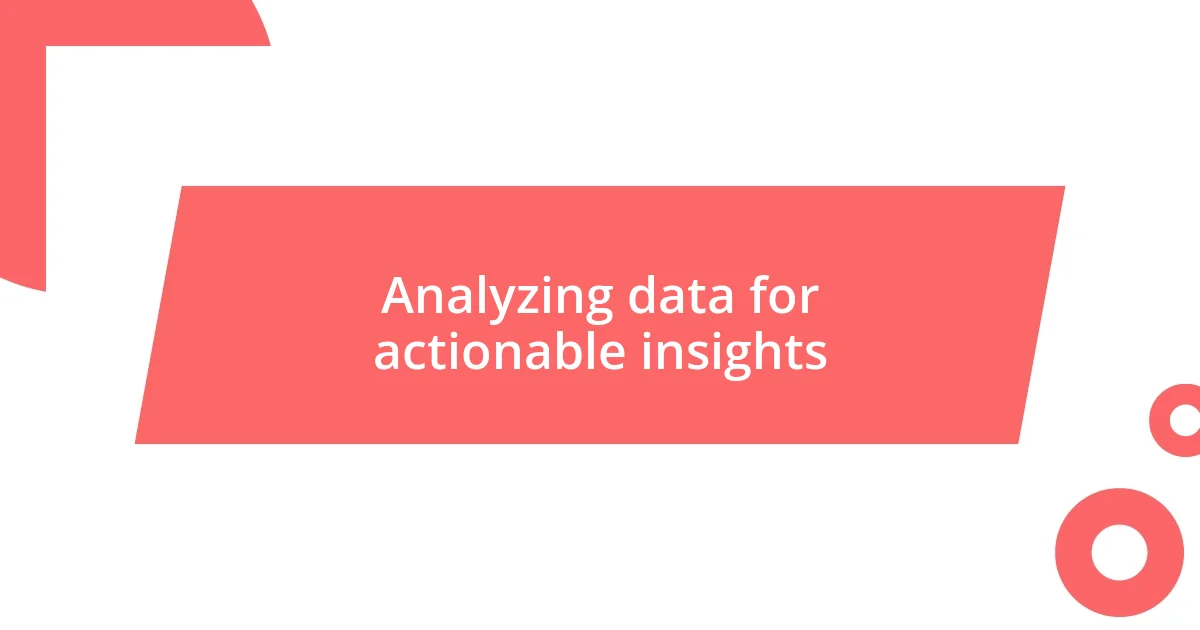
Analyzing data for actionable insights
Analyzing data for actionable insights has truly reshaped my approach to business strategy. In my early days, I often collected vast amounts of data, thinking the more I had, the better my decisions would be. But I quickly learned that without a precise lens to focus on, that data could become a confusing maze. I vividly recall a moment when I analyzed customer feedback and discovered recurring concerns about product features. This insight not only helped me prioritize improvements but also deepened my connection with my customers, as they felt heard and valued.
To get the most out of data analysis, I’ve found the following steps effective:
– Define your objectives: Understand what questions you’re trying to answer.
– Choose relevant metrics: Focus on KPIs that align with your goals.
– Utilize data visualization: Create charts or dashboards to spot trends at a glance.
– Engage with the data: Regularly review and discuss findings with your team to foster a culture of insight.
– Test and iterate: Use insights to test new strategies and be ready to adjust based on results.
As I became more comfortable with analyzing data, I embraced qualitative insights alongside the quantitative ones. There was a time when customer surveys felt like just another checkbox to me. I turned that around by diving into open-ended responses; that’s when the magic happened! It was as if my customers were sharing hidden treasures, revealing their aspirations and disappointments. This deeper understanding fueled innovative changes in our product line that resonated profoundly with our audience. It’s incredible how interactive and personal data can become when you look beyond the surface.
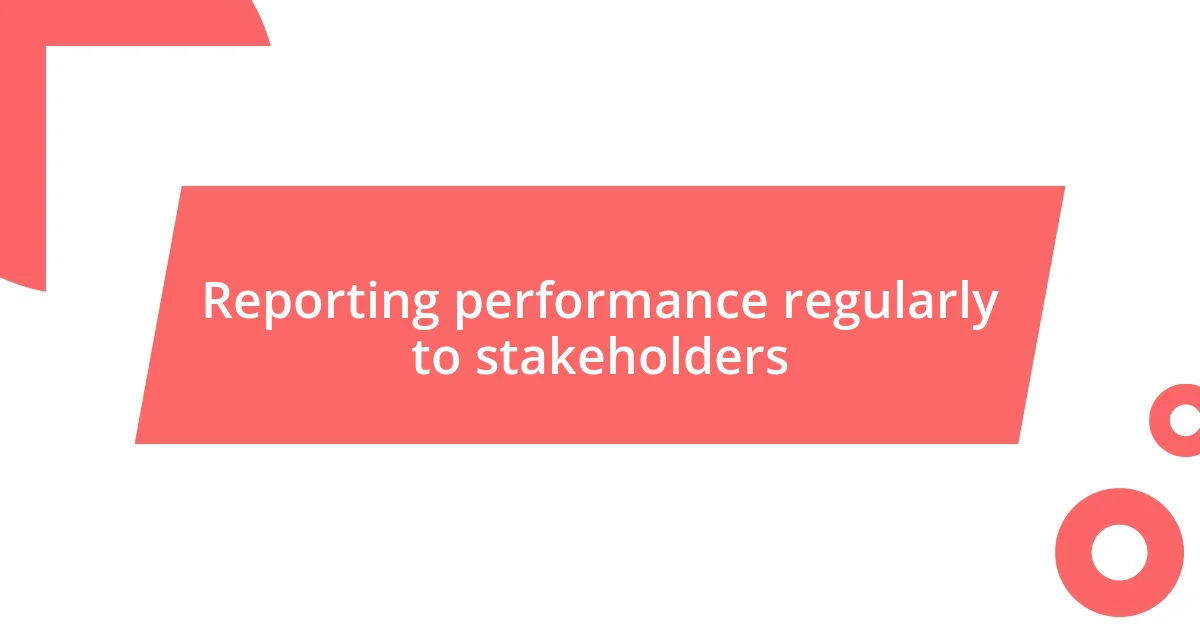
Reporting performance regularly to stakeholders
Reporting performance regularly to stakeholders is not just a formality; it’s a powerful way to keep everyone aligned and informed. I still remember the first quarterly meeting where I presented our performance metrics to the board. As I shared the numbers, I could see their eyes light up with interest. The feedback I received was invaluable, and it reinforced the importance of transparency in building trust and fostering collaboration.
One strategy that worked well for me is creating a visually engaging report that highlights key performance indicators (KPIs) in a way that’s easy to digest. I once put together a simple infographic to illustrate our sales growth over the past year, and the response was overwhelmingly positive. The stakeholders appreciated how much easier it was to grasp complex data. Have you ever tried using visuals to communicate ideas? They can make a world of difference in engagement and understanding.
Incorporating regular updates—whether through monthly newsletters or a quick dashboard presentation—has proven to keep our stakeholders engaged and invested. I noticed that when we shared positive news, like exceeding sales targets, it sparked enthusiasm and encouraged continued support. Conversely, being honest about challenges while also presenting potential solutions has always strengthened our relationships. Wouldn’t you agree that open communication fosters a sense of partnership? In my experience, it truly does, creating a cohesive environment where everyone feels responsible for the business’s success.
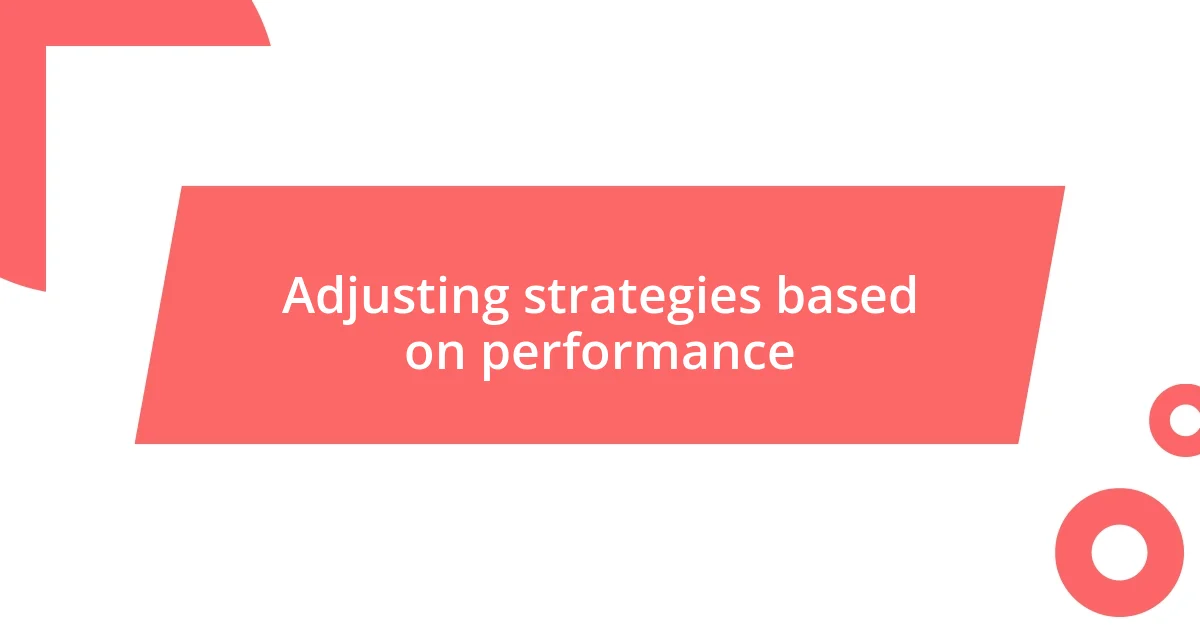
Adjusting strategies based on performance
Adjusting strategies based on performance is an ongoing journey that demands both adaptability and awareness. I remember a pivotal moment when our sales numbers dipped unexpectedly. Rather than panicking, I gathered my team to dissect the data and pinpoint the factors at play. It turned out that a new competitor had disrupted our market, and recognizing this insight allowed us to pivot our marketing approach, addressing the competition directly. Isn’t it fascinating how a small shift in perspective can lead to transformative changes?
One powerful adjustment strategy I’ve harnessed is setting regular review sessions. Every month, I carve out time with my team to evaluate our key performance indicators (KPIs) and discuss what’s working and what isn’t. Recently, we realized our social media engagement was lagging behind industry benchmarks. Instead of waiting for another month to pass, we collaborated to revamp our content strategy immediately. This proactive approach not only energized our marketing but also fostered a sense of ownership among team members. Have you ever felt that electric charge when you work closely with your team to address challenges head-on?
I’ve also learned the importance of being open to experimentation. After noticing a surge in interest for eco-friendly products, I initiated a pilot project to launch a new green line. We carefully tracked performance metrics against our expectations, and while initial sales were modest, customer feedback was overwhelmingly positive. This prompted us to rethink our overall product strategy. The process taught me that agility doesn’t just mean reacting; sometimes, it means leading with innovation and being brave enough to explore new territories. Have you found yourself stepping outside your comfort zone to adjust your business approach? It’s often where the greatest growth lies.
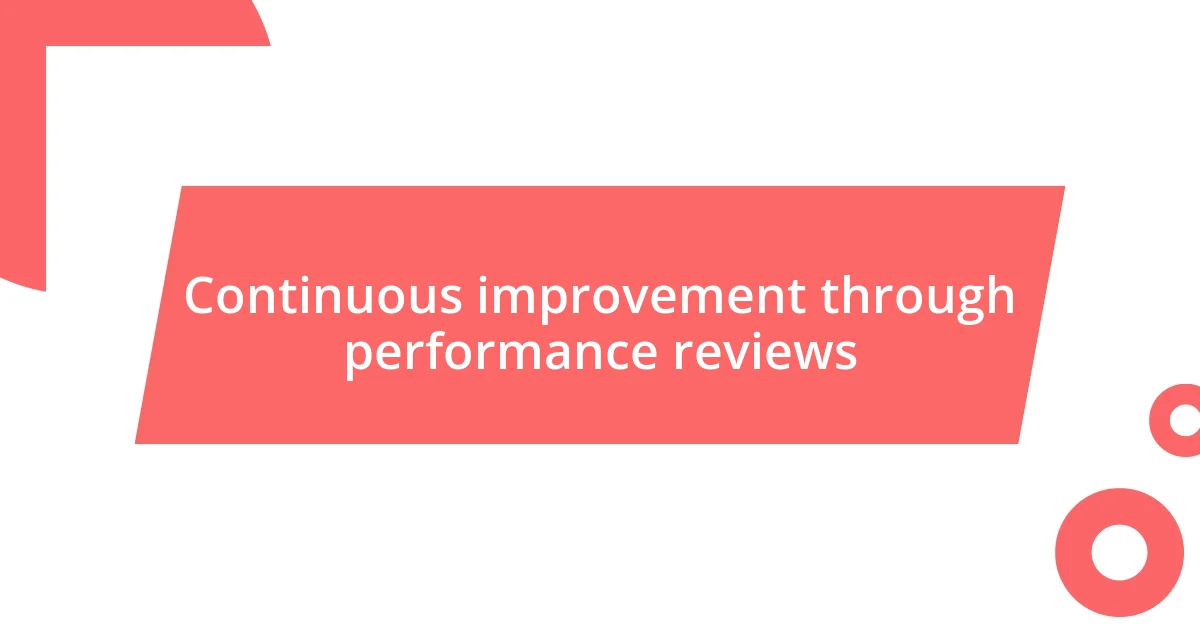
Continuous improvement through performance reviews
Performance reviews are invaluable tools for fostering a culture of continuous improvement within a business. I can’t count how many times I’ve sat down with my team to reflect on our progress and set new goals. One particular session stands out where we identified that our customer service response time was slipping. It was a wake-up call. Rather than just noting the issue, we brainstormed together on ways to enhance our processes, and it ultimately resulted in a training program that not only improved our response time but also boosted team morale.
I’ve always believed that constructive feedback is a powerful catalyst for growth. During a performance review, I vividly recall a colleague expressing concerns about our project timelines. Instead of becoming defensive, I approached their feedback with curiosity, and it sparked a fantastic discussion. We collectively developed a project management tool that increased transparency in our timelines. Have you ever experienced the magic that follows when you truly listen to your team? It’s transformational, and in my experience, it strengthens collaboration and commitment.
By regularly conducting performance reviews, I’ve found that they act like a compass, guiding us toward our goals. In one instance, we realized that our product launch strategies were too rigid and not aligned with market feedback. This prompted a revamp of how we approach launches, which not only made us more responsive but also increased our market success. It’s astonishing how small adjustments, born out of honest reflections during these reviews, can enhance effectiveness and lead to significant improvements across the board. Wouldn’t you agree that creating spaces for honest dialogue within a team can unveil great opportunities for innovation?













